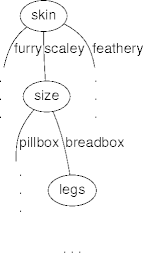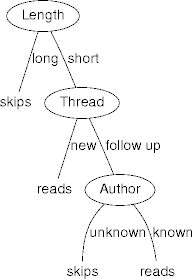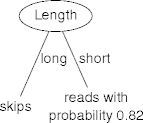Intelligent Systems Lecture Notes
9 November 2011 • Basic Learning
Outline
- Basic learning models.
- Decision trees.
- Linear regression.
- Bayesian classifying.
Let’s Play a Game
- How would you teach a computer to play this game?
I am thinking of an animal.
What kind of skin does it have?
Furry
Is it around the size of a bread box?
Yes
And so on\(\ldots\)
Game-Play Tree
- This is the essence of a decision tree.
|
|
|
Decision Trees
- A decision tree for a target feature is an m-way tree with:
- interior nodes labeled with input features.
- edges labeled with values from the source-node input feature.
- leaves labeled with point predictions for the target feature.
Decision Tree Examples
|
|
|
Trees to Rules
- In a deterministic decision tree each leaf node resolves to a
target domain value.
- Rather than a probability distribution.
- A deterministic decision tree can be turned into a propositional
knowledge base.
- Each leaf value is a rule head.
- The conjunct of edge labels on the path from the root to the leaf is the rule body.
- leafvalue \(\leftarrow\) edgelabel \(\wedge\) \(\cdots\) \(\wedge\) edgelabel
Tree KB Example
|
|
skips \(\leftarrow\) long reads \(\leftarrow\) short \(\wedge\) new skips \(\leftarrow\) reads \(\leftarrow\) |
Selecting Decision Trees
- There are a huge number of decision trees for a given input set.
- A bias can order the candidate trees in decreasing fidelity to the
bias.
- The bias selects for low height trees, low node count trees, best predicting trees, …
- But how are decision trees generated?
Generating Decision Trees
- Given
- an input-feature set \(I\) = { \(I\)1, …, \(I\)k },
- a target feature T, and
- a training-example set E = { \(\ldots\), (\(I\)1, …, \(I\)k, T) }.
- generate a decision tree.
- General idea: pick an input feature, recurse on each input-feature value v to create a subtree rooted at v.
Decision-Tree Generator
decision tree DTG(I, T, E)
if stop here(E)
return point estimate(T, E)
I' = pick(I)
root = node(I')
for v in dom(I')
root.add child(
DTG(I, T, {e ∈ E | val(e, I') = v})
return root
Observations
- There are many stopping criteria.
- Identical target-feature values.
- The point estimator returns the target-feature value.
- The tree depth has maxed out.
- The point estimator returns a probability distribution over the example target-feature values.
- Identical target-feature values.
if stop here(E) return point estimate(T, E)
Stopping Examples.
- Stop with depth 1 trees, predict Action.
- Training examples:
Action Author Thread e1 skips known new e2 reads unknown new e3 skips unknown old e4 skips known old e5 reads known new e6 skips known old 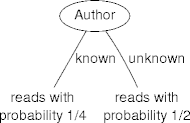
Stopping Examples..
- Stop with no decision needed, predict Action.
- Training examples:
Action Author Thread e1 skips known new e2 reads unknown new e3 skips unknown old e4 skips known old e5 reads known new e6 skips known old 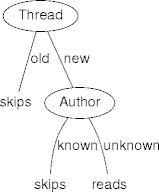
Observations
- There are many ways to pick the next input feature.
- The feature picked should most support the bias.
- Pick randomly, or with greed.
- Greed optimizes exactly the next choice.
- This is the myopically optimal choice.
- Chose large input features before smaller ones.
- Trees have fewer nodes that way.
I' = pick(I)
Using Decision Trees
- Given a decision Tree D and an input set \(I\), predict the target feature value.
- Basic idea: search the tree on the edge labels rather than the node labels.
target feature predict(D, I)
if leaf(D)
return D.label
else
return
predict(D.child[val(I, D.label)], I)
Linear Regression
- A linear function of features \(I\)1, …, \(I\)n is a function of the
form
f w(\(I\)1, …, \(I\)n) = w0 + w1\(I\)1 + \(\cdots\) + wn\(I\)n = w0 + \(\sum\)j wj\(I\)j
- where
w = (w0, …, wn)
- is the weight vector.
Linear Regression
- A linear regression is the output of a linear function of an
input example e and weight vector w):
pval w(e, T) = w0 + w1val(e, \(I\)1) + \(\cdots\) + wnval(e, \(I\)n)
Weight Vector
- The weight vector is a set of knobs for minimizing error.
- Supposing a sum of squares error measure
ErrorE(w) = \(\sum\)e \(\in\) E(val(e, T) - pval w(e, T))2
- find w to minimize ErrorE(w).
Finding Weight Vectors
- Minimizing weight vectors can be computed analytically.
- See any mathematical software system: Mathematica, R, SAS, \(\ldots\)
- There are regression techniques that can’t be handled analytically.
- And error measures too.
- Need a more general approach than closed-form calculation.
Gradient Descent
- When you want to go down hill, step down the slope, not up.
- Gradient descent is the iterative calculation that steps down
the slope.

- \(\eta\) is the learning rate, another knob.
Gradient Descent Code
weight vector GD(I, T, E, η)
wvec = random initialization
repeat
for e in E
δ = val(e, T) - pval(wvec, e, T)
for i in wvec.size
w[i] = w[i] + ηδval(e, I[i])
until done
return wvec
Predicting vs Classifying
- Linear regression naturally predicts numbers.
- How well does it handle classification over finite target feature
domains?
- Map domain values into a number line.

- Map domain values into a number line.
- Linear regression is unbounded. What color is -1? Or 10?
Squashing Linear Functions
- Move from the weighted linear function
f w(\(I\)1, …, \(I\)n) = w0 + w1\(I\)1 + \(\cdots\) + wn\(I\)n
- to the squashed weighted linear function
f w(\(I\)1, …, \(I\)n) = f(w0 + w1\(I\)1 + \(\cdots\) + wn\(I\)n)
- f: \(\mathbb{R} \rightarrow\) [0..1] is the activation function.
Step Activation
- The step function is a simple activation function.


- The step function was the basis for the perceptron, the first learning method (1958).
- The step function is not differentiable, causing problems with gradient descent.
Sigmoid Activation
- The sigmoid (or logistic) function
f(x) = 1/(1 + e-x) 
- is a differentiable activation function.
- Being differentiable, gradient descent can find minimizing weight vectors for sigmoidally squashed linear functions.
Linear Separability
- An input set of n features defines an n-dimensional space.
- Target-feature (boolean) values are at the coordinates.
- An input set is linearly separable iff a n-1-dimensional hyperplane divides the target values into true and false sides.
- A non-boolean valued feature domain can be reduced to a set of boolean feature domains.
Example
- The input set (X, Y) with boolean features is a two-dimensional space, a plane.
- The one-dimensional hyperplane is a line.

Linear Separable Learning
- Sigmoidally squashed linear functions can learn linearly separable
classifications to an arbitrarily small error.
- The hyperplane “passes through” y = 0.5.
- Unfortunately, it is hard to determine if an input set is linearly separable.
To the Doctor’s Again
- Let’s go back to the doctor’s office.
- Straight probability wasn’t helpful. What about conditional probability?
- Suppose a bunch of people get sick in the same way.
- Pr(sniffles | flu) = 0.90
- Pr(aches | flu) = 0.85
- Pr(spots | flu) = 0.07
Natural Categorizations
- A set of hypotheses conditioned by the same evidence is a kind of
classification.
- The evidence is the natural category (or class).
- Hypotheses are feature values.
- The conditional probability is the likelihood the hypothesis is a feature value.
- Given a flu category, we know how confident we can be with sniffle, ache, and spot predictions.
Bayesian Classifiers
- A Bayesian classifier exploits natural categories.
- The input and target features are part of the same natural category.
- Once the category’s identified, determining the feature values follows the probabilities.
- But there’s a problem here. What is it?
Back in the Doctor’s Office
- There’s a patient waiting. What’s wrong?
- What do we know?
- Pr(sniffles | flu) = 0.90
- Pr(aches | flu) = 0.85
- Pr(spots | flu) = 0.07
- The problem is hypothesis are evidence, and evidence is hypothesis.
- We can see sniffles and no spots, but don’t know why.
Bayes’ Rule
- Have Pr(sniffles | flu), want Pr(flu | sniffles).
- Bayes’ rule “turns around” a conditional
probability.
Pr(h | e) = Pr(h \(\wedge\) e)/Pr(e)
Pr(e | h) = Pr(e \(\wedge\) h)/Pr(h)
Pr(h | e)Pr(e) = Pr(h \(\wedge\) e)
Pr(e | h)Pr(h) = Pr(e \(\wedge\) h)Pr(e \(\wedge\) h) = Pr(h \(\wedge\) e)
Pr(h | e)Pr(e) = Pr(e | h)Pr(h)
Example
- Given Pr(sniffles | flu), use Bayes’ rule to get
Pr(flu | sniffles)Pr(sniffles) = Pr(sniffles | flu)Pr(flu) - Divide through by Pr(sniffles):
Pr(flu | sniffles)= Pr(sniffles | flu)Pr(flu)/Pr(sniffles)
Latent Variables
- A latent variable is an unobserved random variable.
- Flu is the latent variable in the doctor’s office example.
- A Bayesian classifier uses Bayes’ rule to find the natural
category as a latent variable.
- And then uses the natural category to predict target-feature values using conditional probabilities.
Naive Bayesian Classifier
- A naive Bayesian classifier assumes
- the input features are independent of each other, and
- the natural category is independent of everything.
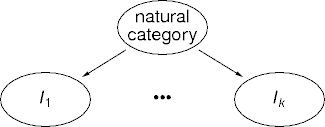
Naive Bayes Classification
- The classifier is defined the belief net and the probabilities
Pr(Category) and Pr(\(I\)j | Category)
- Given input set { \(I\)1 = v1, …, \(I\)k = vk }, find
then predict target-feature values.Pr(Category | \(I\)1, …, \(I\)k) = \(\prod\) Pr(\(I\)i | Category)Pr(Category)
Finding Priors
- The prior probabilities Pr(Category) and Pr(\(I\)j | Category) can be
calculated from the training examples:
Pr(Category = ti) = ni/\(\sum\)j nj
Pr(Category = ti | \(I\) = ij) = nij/\(\sum\)k nkj - where
ni is the ti count.
njk is the count of ij under tk.
Summary
- Decision trees classify target features.
- Liner regressions classify or predict target features.
- Bayesian classifiers use Bayes’ rule to predict categories, and then feature values.
References
- Learning in IS (Chapter 15) in Intelligent Systems by Robert Schalkoff, Jones and Bartlett, 2011.
- Learning from Examples (Chapter 18) in Artifical Intelligence, third edition, by Stuart Russell and Peter Norvig, Prentice Hall, 2010.
| This page last modified on 2011 November 13. |
